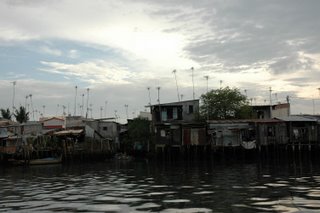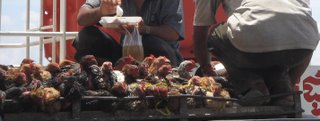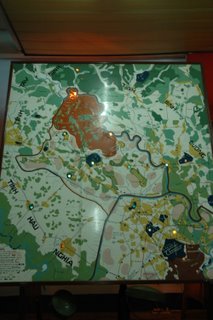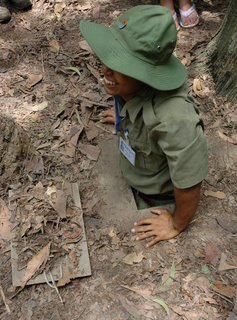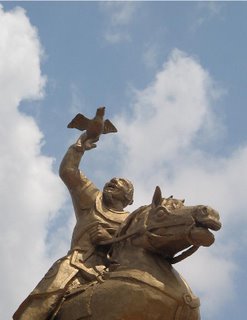
Saigon - from the mosquitos in the air, to the swarms of motorbikes on the roads or the neon lights that short out in the rain, this place buzzes. Time for a quick introduction before I get onto some of the more recent stuff - Vietnam is a country that has nearly always been in a state of repelling foreign invasions or occupiers, twelve centuries of Chinese rule, followed by repeated and unsuccesful attempts by Mongol forces, eventually leading to French colonialism and then war with the US. Interest in Vietnam by French forces commenced around 1847 and for four decades commenced in a fairly disorganized manner. It turned a corner in 1872 when merchant Jean Dupuis seized Hanoi in the north - another, Captain Francis Garnier was sent out to curb his activities but instead began his own conquests in the region. In 1883, Hue was attacked and the Treaty Of Protectorate initiated following the death of Emporer Tu Duc, thus beginning the colonial period properly. Vietnam has a fiercely independant streak, and sustained resistance followed - intensified by disproportionate taxes, appalling working conditions and wages of Vietnamese workers. This layed the foundations for the support of the Vietnam Revolutionary Youth League, formed in 1925 by Nguyen Tat Thanh, or Ho Chi Minh ("Bringer Of Light"). The story of Ho Chi Minh's own life and political course is intextricably linked with the story of Vietnam itself. In 1930 the Revolutionary Youth League was superceded by the Vietnamese Communist Party, and in turn The League For The Indedpendance Of Vietnam (better known as the Viet Minh) was formed in 1941.
France came under German control in 1940, and the Vichy France administration agreed to Japanese military occupation (a useful base for launching other offensives in the region), giving the Viet Minh a new focus for resistance. 1945 brought famine in Tonkin, killing 2 million people - the Viet Minh won many supporters during this time with relief efforts, further increasing their influence in the North. The August Revolution was called by Ho Chi Minh on August 19th and Emporer Bao Dai abdicated on the 25th (though he was made 'Supreme Advisor' to the Viet Minh by Ho). Independence was declared on September 2nd, and North Vietnam declared the Democratic Republic Of Vietnam. Meanwhile, during the Potsdam Conference (July 17 - Aug 2, 1945) one of the items discussed was the dismantling of Japanese occupation in Vietnam - the consensus being that China would accept surrender north of the 16th paralell. British forces took responsibility for the south, and on entering Saigon found it in a state of chaos. Japanese and French troops were released from prisons to assist in bringing order but promptly engaged in hideously violent activity, beating and clubbing men and women and breaking into properties. By this time the Viet Minh had large amounts of influence throughout the country, particularly in the North and a general strike was called and a guerilla war against the French launched. French forces returned to Vietnam and within a few months the Viet Minh were forced to flee Hanoi for the mountains.
Then began the
First Indochina War, a resistance led by the Viet Minh against French colonial forces and lasting from 1946 to 1954. This proved to be yet another bloody chapter in Vietnam's history - around 400,000 people were killed and 600,000 wounded. It reached a head in May 1954 at Dien Bien Phu where French forces suffered a crushing defeated by the Viet Minh under Vo Nguyen Giap. The Geneva Conference of 1954 declared an end to hostilities and the re-partioning of the country at the 17th paralell and leading to mass migration (mostly Catholic from North to South).
Ngo Dinh Diem was installed by the US in the South (the fact that he was vehemently anti-communist probably helped matters), with Bao Dai as constitutional monarch ... Diem's rule proved to be a controversial and often criticized one. This sets the background for the runup to the American War in Vietnam, which I'll save for the next blog entry.

Our own journey to Vietnam necessitated a gruelling peregrination through Cambodia once more - I am collecting Kampuchean visas like the beads of sweat on my forehead. Our steed this time was a "VIP Taxi" as there was some sort of cock-up on the part of the people that sold us the bus ticket - translating to a dusty Toyota Camry with a non-working fuel guage. Our soundtrack was the Cambodian equivalent of R.E.O. Speedwagon - maybe some middle of the road rock was appropriate as that's where we happened to drive most of the time. Companions were a top Aussie chap called Simon and an amiably kinetic French bloke who's name I didn't catch. When I asked what he thought about French Pop (for which I have a certain grinning fondness), he attempted to strangle himself and rolled his eyes wildly. I say again, I have never met a French person that I didn't take an immediate liking to (though the number this is based on is small enough to make a statistics professor draw the Normal Distribution on a board, then put their fist through it in anger).
Saigon itself is very much a city that could be described as 'alive' - or perhaps 'raw' might be a better description. I'm not really sure what I was expecting - while technically a communist state, there were still a number of posho bars and five star hotels - though 2 minutes walk down the road there seems to be things like power and telephone lines just thrown up in improvised places, hanging crazily or stretched nearly to breaking around corners where a car hit the pole and it was never repaired. I was having a drink with a new found friend outside a cafe when she suddenly started screaming and freaking out (I could make some unnecessary self-deprecating joke here, but I'll leave it to you). Concerned, I asked what was up - boredom ? Disagreement on musical tastes or politics ? Freeform interpretive dance ? No, mild electrocution apparantly, from one of the broken fairy lights adorning the entrance - shrugged off by the waiters as "wet hair, eh ?". Fortunately she seemed unharmed, but I'm none too sure about the health and safety rules around here.
In any case, there seemed to be a thriving street market going - no shortage of people trying to make a quick buck out of copied books or chewing gum (USD is the currency of preference - the Dong is certainly the most devalued money we've encountered so far at 29,000 to the quid). You've got to feel a bit sorry for them, even if it is an annoyance at times - though there is no shortage of potential customers even if no more than 1% are completely indifferent. Vietnam has established itself as a near-essential stop on the backpacker trail - quite impressive given that it only re-established diplomatic communications to the US in 1995. It's only when you visit places like this that you realise the effect tourism and the huge influx of dough has on them (Ko Phi Phi was another obvious example). I only hope that much of it doesn't get ruined in the same way that some of the Thai islands have (in a place where there's not a lot of spare cash going around of course people are going to set up shop and take the readies). I got talking to a bloke who works in the Vietnamese tourist industry and he said that it's definately gearing itself up for it, China and Thailand apparantly being the role models. It's strange though, everyone I talked to who was visiting Vietnam seemed to be in a rush to get through it - I don't mean like the awful sort of 'Checkbox Tourism' of just being able to say you've been somewhere - more like just running out of time and not being able to take it in at leisure. I was no exception - I too mismanaged my time in South East Asia and only really got to see a small part of what it has to offer, and I think it's a great shame that so many people choose burn through the country like this. I certainly intend to return sometime in the next few years, places such as Hoi An or Hue fire the imagination just by reading about them.
Here are some of the scenes from around Saigon :

We made a visit to the Reunification Palace, preserved as it was in April 1975 as the Republic Of Vietnam (South Vietnam) crumbled and came under the influence of the North - in a moment relayed around the world, tanks came crashing through the front gates on 30th April. The Norodom Palace originally sat at the site, completed in 1868 for the French governer of Cochinchina - later to become Diem's place of operation. So hated was he that his own air force bombed the palace in 1962, though it failed to kill him. A new place was built on the site, but Diem was murdered in 1963 and did not see it's completion in '66. It was named the Independance Palace, and South Vietnamese President Nguyen Van Thieu resided here until 1975.

Architect Ngo Viet Thu incorporated a number of characters into the facade to represent different hopes and aspirations for the nation. For example, the character Trung relates to consistancy, Tam for "knowing others, oneself, the art of fighting", Chu for power and Hung for prosperity. See the diagram, left - presented to you in glorious Crap-O-Vision, dodgy drawing by me and blurry JPEG artifacts courtesy of MS Paint. Don't blame me in any way shape or form if this is even slightly wrong - I know even less about Chinese script than I do about Vietnamese architecture (i.e. enough to be completely wrong).
The insides were just as grand - huge open hallways, clearly showing a very strong Chinese influence in the decorations, chandaliered meeting and dining rooms and, er, a movie theatre. I was more interested in what was in the basement, however - a warren of tunnels and bunkers still stocked with a very retro line of typewriters and radio equipment. Old maps still adorned the walls - quite a spooky air to it, I tried imagining what it would have been like down there when everything was kicking off.

I bet it was a barrel of laughs down here.

"Uncle Ho" - founder of the Viet Minh, Prime Minister from 1946-55 and President from 1955-69 of North Vietnam.

Notre Dame cathedral - built between 1877 and 1883.
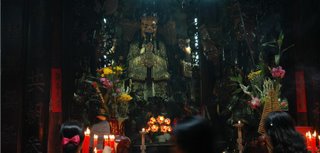
Inside the Jade Emporer Pagoda, Cholon district - built in 1909, one of the most striking and atmospheric temples I've been in, full of Buddhist and Tao figures.
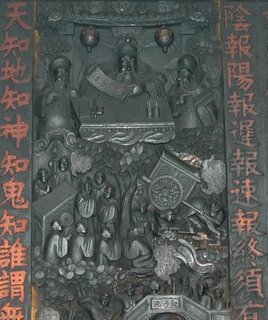
Intricate woodcarvings depict scenes of torment in the afterlife in the Hall Of The Ten Hells. A judge of the Ten Regions reads from a book detailing the accused's life of crimes.
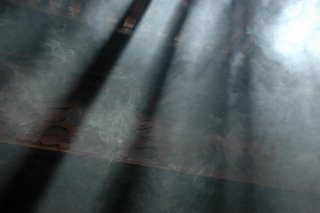
Incense smoke fills the air

A driver asleep in his cyclo - despite the slight annoyance of these guys persistantly asking if you want a lift, I think they work pretty hard. Many of them were apparantly doctors or teachers before the war, but those who sided with American forces were stripped of citizenship and as such cannot return to their former jobs and lives.
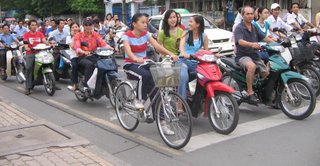
The traffic in the city is complete madness, rivalling Mumbai in terms of density - though motorbike seems to be the standard way of getting around. It's not particularly quick, but it's quick and dense enough to make crossing the road a real test of nerves ...

... and at night you've got no chance.
 Watching the pottery work on a day trip to Ko Kret
Watching the pottery work on a day trip to Ko Kret A favourite pastime in South East Asia is the traditional game of "Stuff Livestock With Precious Metals". Dan and I got into this in a big way. So far 30 cows have kicked the bucket with silver, 79 geese had their fill of bronze and we managed a staggering 288 Cadmium Yaks. YUSS !
A favourite pastime in South East Asia is the traditional game of "Stuff Livestock With Precious Metals". Dan and I got into this in a big way. So far 30 cows have kicked the bucket with silver, 79 geese had their fill of bronze and we managed a staggering 288 Cadmium Yaks. YUSS ! Edible flowers at the market in Ko Kret - the blue ones had a very odd, sweet and greasy taste.
Edible flowers at the market in Ko Kret - the blue ones had a very odd, sweet and greasy taste.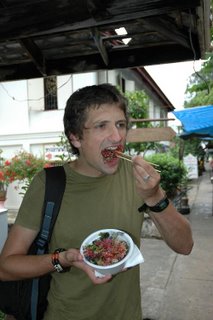 Dan gave them a bit more of a chance than I did. That's right Son, get 'em down yer throat !
Dan gave them a bit more of a chance than I did. That's right Son, get 'em down yer throat !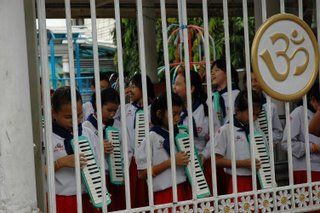 I hate melodicas, more so than any other instrument. Who made these bastard things popular again ? I have a strong suspicion it was Damon Albarn. Anyway, this is Bangkok's Melodica Army - behind bars. Where they belong.
I hate melodicas, more so than any other instrument. Who made these bastard things popular again ? I have a strong suspicion it was Damon Albarn. Anyway, this is Bangkok's Melodica Army - behind bars. Where they belong. Detail of the Golden Temple
Detail of the Golden Temple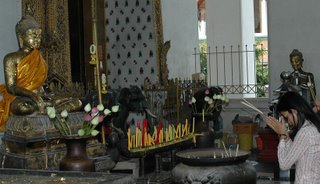 Our mate Kung, who kindly allowed me to take a picture while she was praying at Wat Su That.
Our mate Kung, who kindly allowed me to take a picture while she was praying at Wat Su That.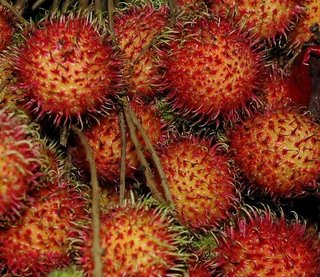 Rambutan - a sort of lychee, often hospitably served up to us, often very unsubtley left uneaten (after making a big show of eating one each).
Rambutan - a sort of lychee, often hospitably served up to us, often very unsubtley left uneaten (after making a big show of eating one each).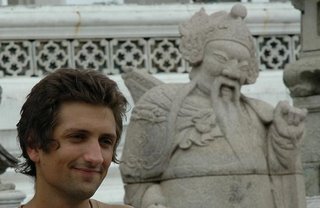 What a photogenic chap, how thoughtful looking ... oh no ! Look who's blundered into frame - get out, get out !
What a photogenic chap, how thoughtful looking ... oh no ! Look who's blundered into frame - get out, get out !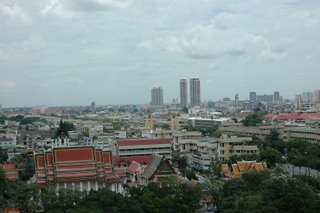 A view over Bangkok, from the Golden Mount
A view over Bangkok, from the Golden Mount









